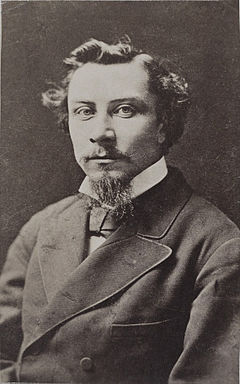Prominent Poles
Henryk Siemiradzki (born Henryk Hektor Siemiradzki) painter best remembered for his monumental Academic art.

Born: November 15, 1843, Bilhorod (or perhaps Novobelgorod), Russia (Presently Ukraine)
Died: August 26, 1902, Strzalkowo (near Czestochowa), Austro-Hungarian partition of Poland (presently Poland)
Early days. Siemiradzki was born to a Polish noble szlachta family of a physician, Hipolit Siemiradzki, high officer in the Imperial Russian army and Michalina (nee Pruszynska) in their estate at the village of Bilhorod (Bialogrod), or Novobelgorod (now Pechenegi, sources vary) near the city of Kharkiv in the Russian Empire (now Ukraine). Still he was raised in Polish tradition. His parents were close friends with Adam Mickiewicz's family. Henryk Siemiradzki studied at Kharkiv Gymnasium where he first learned painting under the local school teacher, D.I. Besperchy. He entered the Physics-Mathematics School of Kharkiv University and studied natural sciences there with great interest, but also continued to paint. After graduating from the University with the degree of a "Kandidat" he abandoned his scientific career and moved to Saint Petersburg to study painting at the Imperial Academy of Arts in the years 1864-1870. Upon his graduation he was awarded a gold medal. In 1870-1871 he studied under Karl von Piloty in Munich on a grant from the Academy. In 1872 he moved to Rome and with time, built a studio there on Via Gaeta, while spending summers at his estate in Strzalkowo near Czestochowa in Poland.
Career. In 1873 he received the title of Academician of the Imperial Academy of Arts for his painting Christ and a Sinner, based on a verse from Tolstoy. In 1878 he received the French National Order of the Legion of Honor and a Gold Medal of the Paris World's fair for the painting Flower vase. In 1876-1879 Siemiradzki worked on frescoes for the Cathedral of Christ the Savior (Moscow) among his other large-scale projects. In 1879 he offered one of his best-known works, the enormous Pochodnie Nerona (Nero's torches), painted around 1876, to the newly-formed Polish National Museum. The artwork is on display at the Siemiradzki Room of the Sukiennice Museum in the Krakow Old Town, the most popular branch of the museum today. Around 1893 Siemiradzki worked on two large paintings for the State Historical Museum (Moscow), in 1894 produced his monumental curtain for the Juliusz Slowacki Theater in Krakow and in 1900 another monumental curtain for the theater in Lwow . He died in Strzalkowo in 1902 and was buried originally in Warsaw, but later his remains were moved to the national Pantheon on Skalka in Krakow.
Personal. In 1873 he married his 18-years old cousin Maria Pruszynska. They had four children. Siemiradzki befriended Polish writer, a future Nobel prize winner, Henryk Sienkiewicz.
Awards, honors. 1878 French National Order of the Legion of Honor; Gold Medal of the Paris World's Fair; honorary membership of Poznan Society of Friends of Sciences; burial in the national Pantheon on Skałka in Krakow.
Source:
Wikipedia (includes a list of many of his works)
Text is available under the Creative Commons Attribution-ShareAlike License; additional terms may apply.
Other sources:
Wikipedia (in Polish)
Olga's Gallery (includes reproductions of 34 Siemiradzki's paintings)
Bonham's auctions
Return to home page:
Prominent Poles
